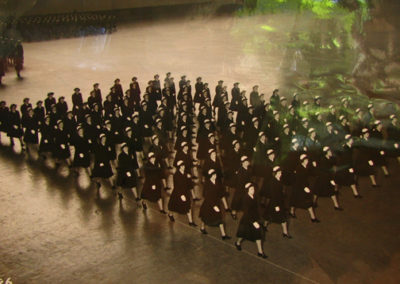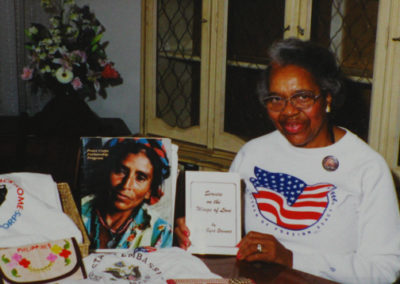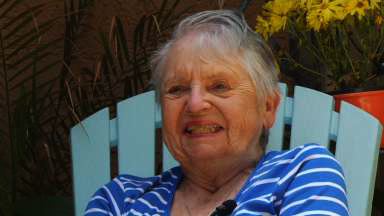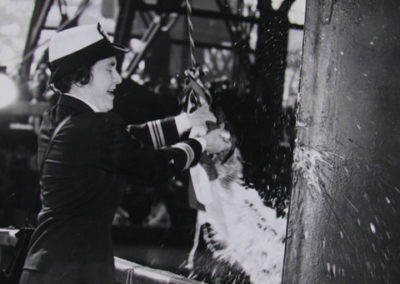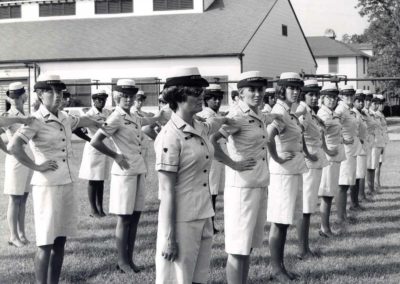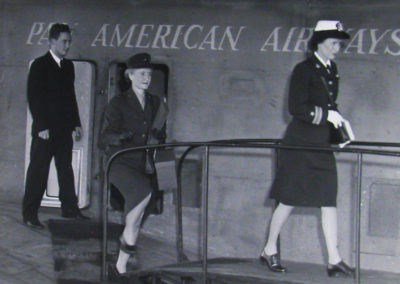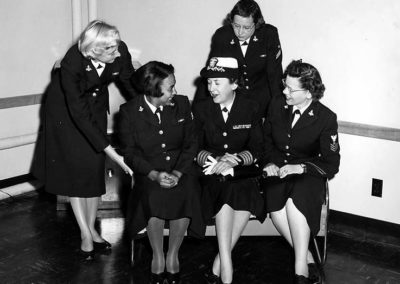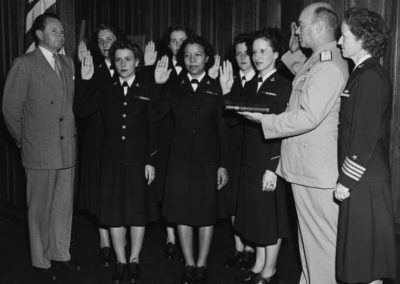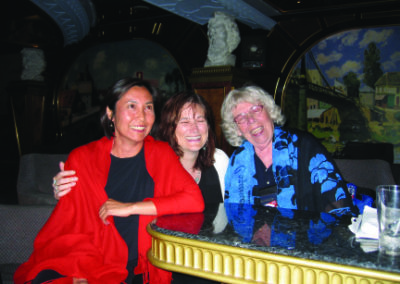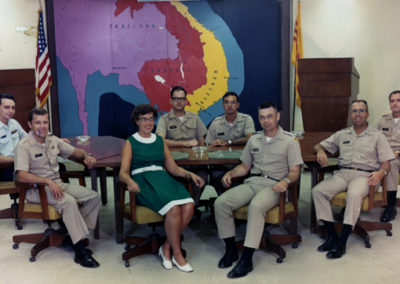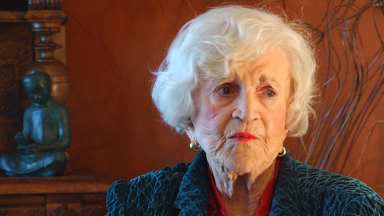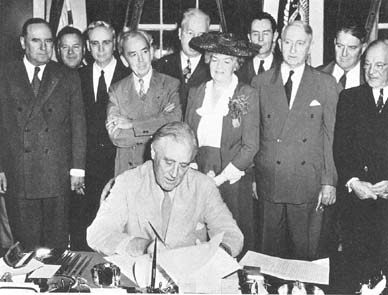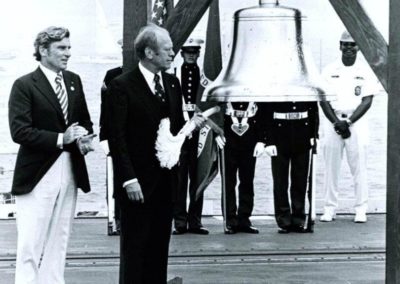After the WAVES
When women signed up for the WAVES, they enlisted for the duration of the war, plus six months. But as demobilization began, the Navy discovered that the women had become a crucial element of military service. And the women discovered that military service had an unexpected impact on their post-war lives.
After the waves
Post War Adjustments
As the war ended and the Navy was decommissioning its forces, male and female, it ran into a problem which becomes obvious with hindsight: there weren’t enough active duty personnel to keep the Navy operational. Leaders, including the now-supportive Captain Nimitz, were impressed by the competency of the WAVES during wartime. They recommended that women be made a permanent part of the Navy. Similar arguments were being made in favor of keeping women in other service branches as well.
Bitter Battle, Again
Remembering the 1942 debates about if it was “proper” for women to be part of an emergency wartime service, Congress braced for another bitter battle in 1947 as the question was raised if women should serve in a peacetime military.
Contentious hearings were held on Capitol Hill. At one point Congressman Dewey Short insinuated that Navy women who left military service due to pregnancy were bearing children out of wedlock.
Joy Bright Hancock was testifying at the time, but it was Congressman James E. Van Zandt who, as she recalled:
leaped to his feet and admonished his colleague, “I do think the Captain should have an apology for that implication, if that’s what you’re implying!” No further questions arose on the issue.
The Naval Women’s Reserve
The legacy of the WAVES and other World War II military women eventually won over Congress. The Women’s Reserve became a permanent part of the Navy on July 30, 1948.
The Women’s Armed Services Integration Act placed severe limitations on the numbers of women in all branches of the service, limiting ranks and potential for advancement. Nonetheless, as Jean Ebbert and Mary-Beth Hall note:
The act represented a remarkable advancement for Navy women. Now they could capitalize on what the WAVES had won: a career in the peacetime Navy.
The total female force was initially limited at about 500 officers and six thousand enlisted personnel, far fewer than the 1000,000+ women the Navy during World War II. The first six of those enlisted women to be accepted into the regular Navy were sworn in on July 7, 1948. All had served as World War II WAVES.
New WAVES Leadership
In 1945, Mildred McAfee resigned from active duty and returned to her position as Wellesley College. She was replaced as WAVES commander first by Jean Palmer (1945-1946) and then by former yeomanette Joy Bright Hancock (1946-1953). Louise K. “Billye” Wilde, the former WAVES P.R. Officer, took over after Hancock resigned (1953-1957). Other WAVES commanders would be:
- Winifred Quick Collins (1957-1962)
- Viola B. Sanders (1962-1966)
- Rita Lenihan (1966-1970)
- Robin L. Quigley (1970-1972)
After the waves
The Regular Navy
After the Korean and Vietnam Wars, service branches began looking at how women should be integrated into the regular service, including formal training at service academies or non-wartime service in all-volunteer forces like the Coast Guard.
The End of the SPARS
The SPARs unit was inactivated on July 25, 1947. In 1949, President Harry Truman signed legislation allowing the Coast Guard to reestablish its woman’s reserve, and the following year the Coast Guard began a campaign to reenlist former SPARs.
In the Military
The women’s reserve units would remain part of the military until the early 1970s. In 1972, the military was integrated for enlisted women, and in 1975 President Gerald Ford signed legislation allowing women into the military Service Academies. The next fall, women began officer training at Annapolis (Navy), New London (Coast Guard), West Point (Army), and Colorado Springs (Air Force).
The Legacy
I went to a reunion, the 50th Anniversary of the WAVES in Norfolk, Virginia.-then I met this woman who was a captain. She was only about 40 or something but she was a captain and we got to talking about it and she told me how important that the World War II WAVES were because they were the pioneers that got things started, and she said she never would have been able to be a captain at her age if somebody else hadn’t done things beforehand.
– Margaret Anderson Thorngate, World War II Navy WAVE
After the waves
Outside the Navy
While the World War II-era propaganda encouraged women to return to the home after the war, women who served as WAVES and SPARs often moved into the workforce and public life.
Pride in Service
Mildred McAfee Horton said when she talked with women who had joined the Navy during World War II, they looked back on their service with pride:
They liked belonging to a great branch of the service. Whichever it was, its members knew it was the greatest branch and were proud to be identified with the power and might of the United States . . . Whatever their future, they face it with the conviction that, having shared military service with the men of their generation, they face the problems of the future with a special understanding of how those problems look to male contemporaries who have been in service. With their femininity accented, they thus emerge from the war as more experienced and interesting people.
Fading Into the Woodwork
While McAfee’s observations may be true, the women report a different post-war experience. While proud, they often didn’t talk about their military service with others. Eileen Horner Blakely says even now she reads obituaries of women she knows who never told her they served during World War II in the WAVES.
We did the job and went home . . . You faded back into the woodwork.
Serving the Community
Many former WAVES worked in community oriented jobs after their military service. A large number of the women interviewed got jobs as teachers. This isn’t terribly surprising since before the war this had become an “acceptable” job for women.
But women also worked to improve their communities in other ways. Instead of fading into the woodwork, women interviewed got involved in politics at the local level (serving on a school board or community boards), were involved with state-level reforms or even, like Jean Byrd Stewart, above, joined the Peace Corps.
Civil Service
A number of former WAVES and SPARs continued working with the government or military, but as civilians rather than military personnel. And they had some fascinating experiences. Susan Ahn spent more than a decade working for National Security. Doris Mansfield Leichliter ended up in Vietnam as a civil service worker. She arrived during the Fall of Saigon:
When we got to the hotel the captain said, “Now when we stop the Jeep, don’t worry about your suitcase. You just run into the lobby and we’ll bring your suitcase in” . . . They assigned me to a room on the second floor with a Red Cross girl. All night, we could hear the shooting going on. They covered the windows with dark curtains. So she looked out the curtains on one side and I looked out on the other and we saw lots of Jeeps going down the street, open air Jeeps with lots of bodies hanging out the back . . . So the next morning she decides she wasn’t going to stay. Somehow she got the Red Cross to agree to take her back home. But I was obligated for two years.
After the waves
The WAVES’ Legacy
Historians are divided as to the legacy of working women in World War II. Some see the women as being a temporary disruption of societal norms, while other see the women as causing some societal shifts.
For the women who served as WAVES and SPARs, however, their legacy is clear.
“We Did It”
When we broke into that man’s world, the Navy, the United States Navy – women? Ugh, ew! And when we did that and made them respect us -when I see Navy officers today who are women, Admirals, I think, “Hot damn, we did it! We did it!”
– Helen Edgar Gilbert, World War II Navy WAVE
Where I Was Supposed To Be
Why did I enlist? I was a very shy, naive person from a rural area. I had never been more than twenty miles from home. I had just graduated from high school and participated in very few things. I don’t know, except it felt like I was supposed to. At this time in my life it was where I was supposed to be. It turned out that it was true. I was very lucky. I was beginning to feel some of what we say, “If you listen, you will know what to do with your life.”
– Anna Fogelman, World War II Navy WAVE
We’re Not Going to do That
I didn’t know until probably the last five years that all these other women felt the same way. And we were together and we talking about having to get permission to go into the service and having to do this and having to do that, and one of the women said, “Well I taught my daughters they didn’t have to to anything they didn’t want to do!” We realized we were getting shortchanged. So in many ways we produced the girls in the ‘60s who went out and said, “We’re not going to to that.”
– Jane Ashcraft Fisher, World War II Coast Guard SPAR
Hinges of History
I think the WAVES . . . are kind of the hinges of history. They were there when the world changed. And they didn’t cause it particularly but it wouldn’t have happened in the same way if the women hadn’t have been there. We were the hinge. We grew up in this old world watching our mothers and our fathers and then our marriages were completely different. For instance, the father was the head of the house. And you had to get, if it was a serious decision he made it. But Mother picked the day to bring it up. Mother made his favorite meal. Mother got everything all organized so he feeling mellow and stuff. There were all these different ways that nobody bothers to do anymore, but they were kind of survival things. They were just the way the world went smoothly that way . . . But what happened? They didn’t stay. The feminist movement popped all over. It was as if it wasn’t going, it wasn’t fitting anymore.
– Josette Demody Wingo, World War II Navy WAVE

